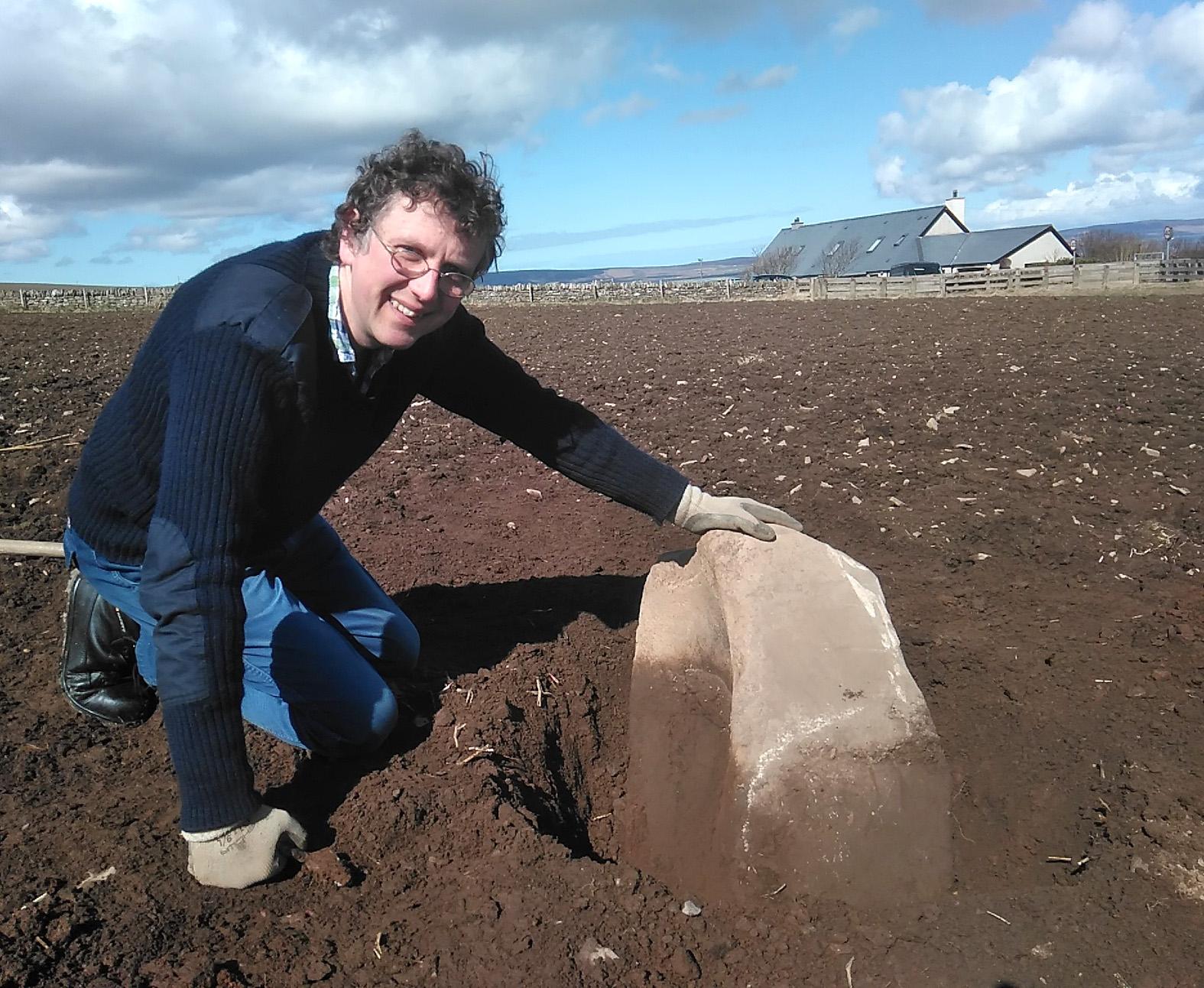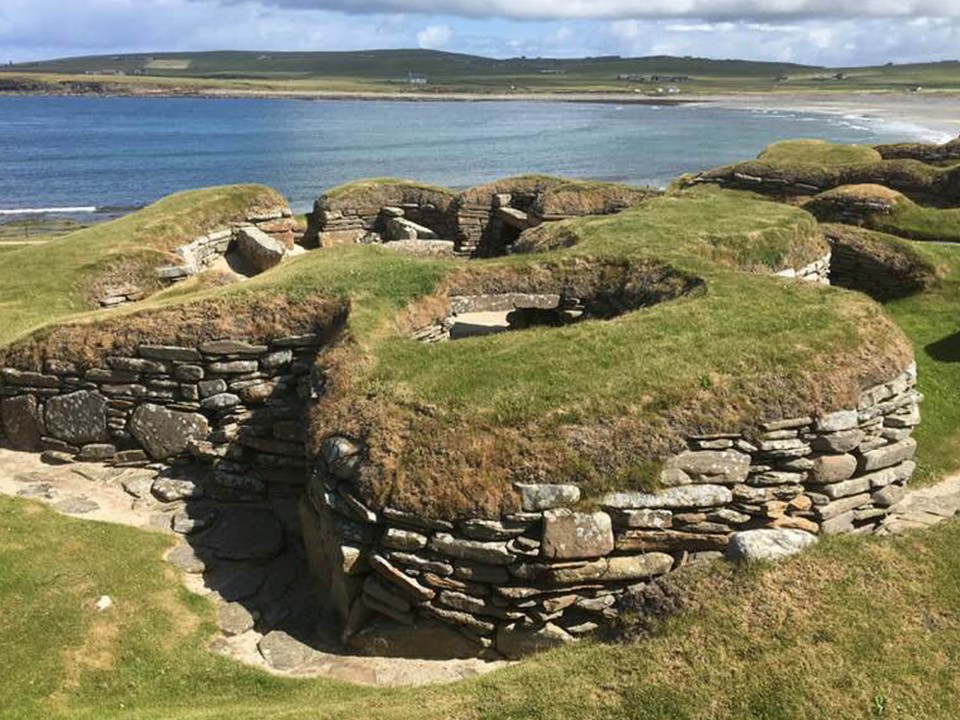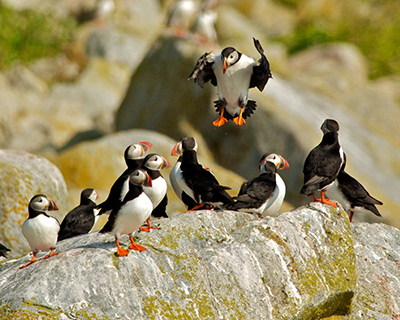Anthropology
Related: About this forumAncient settlement 'older than Skara Brae' emerges on Orkney
Remains of an ancient settlement in Orkney which is thought to pre-date Skara Brae by hundreds of years have emerged.
By Alison Campsie
Monday, 26th April 2021, 5:28 pm

Chris Gee of the Archaeology Institute at University of Highlands and Islands with the quernstone, which was used to grind corn. The find adds more evidence to the belief that a settlement could have been made here between 3600-3200BC, hundreds of years before the world-famous Skara Brae. PIC: UHI Archaeology Institute.
A huge prehistoric quernstone was struck upon by farmers ploughing fields near Saverock, St Ola, earlier this month.
The saddle quern, which was used for grinding grain concealed a layer of sherds of Early Neolithic pottery.
Earlier finds, including an arrow head and further pieces of broken vessel have suggested an Early Neolithic date (c3600-3200BC) for the Saverock settlement, meaning it pre-dates Skara Brae, Orkney’s best-known New Stone Age settlement by centuries.
Skara Brae was first occupied around 3,100 BC, it is believed.
. . .
The discovery was made at the vast Ness of Brodgar site, a complex of monumental buildings that forms part of the Heart of Neolithic Orkney World Heritage Site.
More:
https://www.scotsman.com/heritage-and-retro/heritage/ancient-settlement-older-than-skara-brae-emerges-on-orkney-3214808
~ ~ ~
Please take the time, if the subject interests you, to scan the images of the "Ness of Brodgar" site, so deeply interesting:
https://tinyurl.com/38uz47ah
https://encrypted-tbn0.gstatic.com/images?q=tbn:ANd9GcQFPS3Bl2t-I2rNERASPuIiAEm0qSJXb-Cmow&usqp=CAU

Neolithic discovery: why Orkney is the centre of ancient Britain
Long before the Egyptians began the pyramids, Neolithic man built a vast temple complex at the top of what is now Scotland. Robin McKie visits the astonishing Ness of Brodgar
Robin McKie
Sat 6 Oct 2012 14.22 EDT
Circle of life: the Ring of Brodgar – a stone circle, or henge – is a World Heritage Site. Photograph: Adam Stanford
Robin McKie
Sat 6 Oct 2012 14.22 EDT
Drive west from Orkney's capital, Kirkwall, and then head north on the narrow B9055 and you will reach a single stone monolith that guards the entrance to a spit of land known as the Ness of Brodgar. The promontory separates the island's two largest bodies of freshwater, the Loch of Stenness and the Loch of Harray. At their furthest edges, the lochs' peaty brown water laps against fields and hills that form a natural amphitheatre; a landscape peppered with giant rings of stone, chambered cairns, ancient villages and other archaeological riches.
This is the heartland of the Neolithic North, a bleak, mysterious place that has made Orkney a magnet for archaeologists, historians and other researchers. For decades they have tramped the island measuring and ex- cavating its great Stone Age sites. The land was surveyed, mapped and known until a recent chance discovery revealed that for all their attention, scientists had completely overlooked a Neolithic treasure that utterly eclipses all others on Orkney – and in the rest of Europe.
This is the temple complex of the Ness of Brodgar, and its size, complexity and sophistication have left archaeologists desperately struggling to find superlatives to describe the wonders they found there. "We have discovered a Neolithic temple complex that is without parallel in western Europe. Yet for decades we thought it was just a hill made of glacial moraine," says discoverer Nick Card of the Orkney Research Centre for Archaeology. "In fact the place is entirely manmade, although it covers more than six acres of land."
Once protected by two giant walls, each more than 100m long and 4m high, the complex at Ness contained more than a dozen large temples – one measured almost 25m square – that were linked to outhouses and kitchens by carefully constructed stone pavements. The bones of sacrificed cattle, elegantly made pottery and pieces of painted ceramics lie scattered round the site. The exact purpose of the complex is a mystery, though it is clearly ancient. Some parts were constructed more than 5,000 years ago.
More:
https://www.theguardian.com/science/2012/oct/06/orkney-temple-centre-ancient-britain
elleng
(141,889 posts)csziggy
(34,189 posts)Went to Skara Brae and the archaelogical dig at the Ness of Brodgar. At the end of each year's dig, they do an open house. It was great with talks by the people working the site and getting to ask questions.
I searched around the Main Island and this location is actually near Wideford Hill towards Kirkwall on the Finstown road.
Here are my blog entries for the Orkneys - warning LOTS of pictures:
Saturday, 17 August – Coach tour to Scapa Flow, Skara Brae and Skraill House
Saturday, 17 August – Ring of Brogdar, Stenness Stones
Sunday, 18 August – The Orkney Main Island – RSPB Cottascarth, RSPB Birsay Moors, Maeshowe
Sunday, 18 August 2019 – The Ness of Brodgar, and RSPB The Loons and The Listening Wall
Judi Lynn
(164,038 posts)What a trip that had to be.
I quickly scanned the first one, and really want to look at it, and the others far more closely.
No doubt whatsoever, as archeologists toil away there, year after year, we eventually are going to be shocked by the images that will come to life about a time in the world which was formerly lost altogether.
The boundaries are definitely shifting continually, making it all far more amazing.
Fascinating idea for a vacation.
Thanks for the links and the food for thought. ![]()
csziggy
(34,189 posts)We took the Queen Elizabeth out of Fort Lauderdale, stopped in New York City for one day (American Museum of Natural History), Halifax Nova Scotia (bus tour), St. Johns, Newfoundland (bus tour), Iceland (Vigur Island for puffins), Rekjavik (boat tour to see puffins), got off early at Port Glasgow, Loch Lomond (too rainy and foggy to see across the loch), traveled through Northern Scotland, out to the Orkneys, down the east coast of Scotland to Hadrian's Wall, one day in the Lake District, back to the East coast of England, down to Dover (too rainy and foggy to see the White Cliffs), back to Bury St. Edmunds to join a needlework class and tour that ended in London, a week in London (British Museum, Victoria & Albert, and the Natural History Museum), off to Wales, from bottom to top and back, out the Cornish peninsula to Land's End, the Jurassic Coast, Stonehenge (slightly rainy and foggy), then to Southampton to get on a Royal Caribean ship that went to four islands in the Caribbean, and back to Fort Lauderdale.
It was the trip of a lifetime! With stopping to see my sister going and coming, we were away from home four months. I've got up to London on my blog and just have not been able to finish the trip. I'll probably get the pictures from the trip sorted and put into photo albums on my site with just captions rather than trying to write a narrative.
Judi Lynn
(164,038 posts)Don't know how you could bring yourself to go home! My gosh.
I was thinking while reading the post that it would have been great to have a lot of photos. If you'll put a link somewhere at D.U., no doubt you will get tons of visitors!
All that and some islands, too, for dessert! Holy moly.
That would be a total dream vacation! Such interesting places. Thanks.



